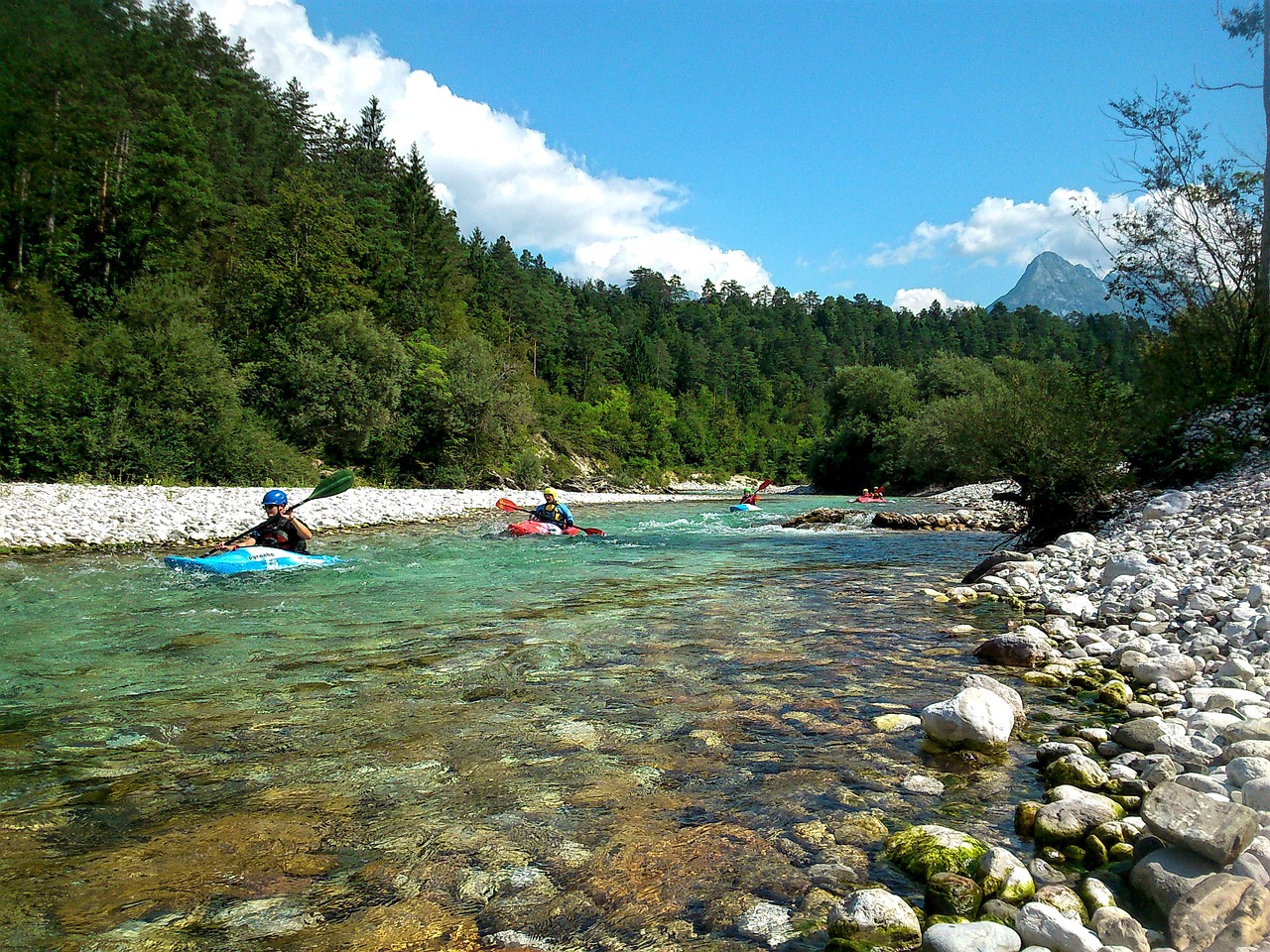
Most people look at fast and turbulent waters and see danger. But there’s an entirely different breed that looks at the same raging torrent and sees fun and challenge. They embark on paddling missions that most people would describe as suicidal.
Yep, you’d have to be pretty nuts to be a whitewater kayaker.
However, the challenge of taking the mighty force of nature head on and the adrenaline rush of navigating a raging torrent is what keeps these thrill-seekers coming back for more. Many see it as the pinnacle of kayaking due to the precision and expertise required.
If you’re in awe of this fearless bunch of kayakers and you want to test yourself on whitewater, our guide will provide you with the steps to get started.
And by the way, these are baby steps we’ve outlined. If you hadn’t guessed, whitewater kayaking is inherently dangerous and comes with many hazards you’ll want to avoid. It will take time before you have the skill and confidence to navigate class IV rapids.
When learning how to white water kayak, it’s always prudent to start with what could go wrong, so let’s begin there.
Dangers of Whitewater Kayaking
River hazards are one of the most common dangers of whitewater kayaking. To minimize risk, it is critical that you take several river paddling lessons with a guide. Nothing can replace real instruction on the water. However, you can kick start your education by reading this great resource on river hazards.
While river hazards are prominent, they’re not the only risk. Remember that weather, drowning, and hypothermia may all also be dangers lurking for those unprepared.
Among many other rules, be certain to always paddle with a group of people and scout your route every time. Keep yourself alive to paddle another day by carrying and knowing how to use essential safety equipment.
Keeping yourself in good physical fitness and being able to swim will also help to mitigate risks if things go wrong. If you can’t swim yet, then you should think about…
Taking Lessons

Beginner river kayaking course in action
You’ve got to be skilled and experienced before attempting whitewater. You have to be swift and responsive to deal with the rapidly changing watercourse and river conditions.
To develop the necessary skill set to the degree that you can confidently remain in control of your boat at all times, you have to take lessons. This is absolutely vital and non-negotiable. And it’s very important that you learn from a certified guide. Your friends may have done the training, be deemed competent, and be accomplished paddlers, but that doesn’t necessarily make them the best person to teach you whitewater skills.
By working with a guide in a safe learning environment, you’ll be able to learn all of the core competencies and drill them to a point they become natural when under pressure. This way, you’re much more likely to remember and apply these important lessons when you’re out paddling on your own.
Look for whitewater services in your area and call around to see which livery offers the best lessons at the most reasonable rates. Make sure to inquire about the training and certification of your instructor.
What You’ll Learn
Whitewater training will almost always start off in flat water conditions, like a lake or swimming pool. You need to get comfortable with balancing, learn paddle strokes, and be able to perform basic safety maneuvers before you attempt anything on moving water.
After you’ve got the hang of the forward, sweep, and back strokes, you’ll move onto some of the more complicated safety maneuvers.
The wet exit – which is where you escape from your kayak when upside down – is a hugely important skill that you’ll drill numerous times. Being able to swiftly exit your kayak when underwater will stop you from panicking when the event occurs.
Building on from the wet exit is the roll. This maneuver teaches you to flip your kayak right way up so that you don’t have to exit underwater. It takes some practice to learn, and how quick you take it up will depend on your athletic ability and how at ease you feel underwater.
After you can confidently perform the essential skills and your instructor gives you the go ahead, you’re next lessons will take place on slow-moving rivers possibly with some very gentle rapids (class I and II at most). Before or during these lessons, your instructor will make you aware of common river hazards and may go over how river difficulty is classified. Here’s a quick primer:
The International Scale of River Difficulty
- Class I (Beginner) - Fast current with some easily seen obstructions.
- Class II (Novice) – Gentle rapids with drops and eddies. Easily traversed with basic skills.
- Class III (Intermediate) – Rapids picking up in intensity. Prepare for big waves and back eddies. Previous experience of whitewater is required.
- Class IV (Advanced) - Large waves, whirlpools, and strong eddies. Rapids should only be attempted by an experienced group with full safety equipment available.
- Class V (Expert) – These rapids are treacherous and should only be attempted by the most experienced paddlers. Expect ferocious conditions with raging rapids, powerful back eddies, whirlpools, and unavoidable obstacles. Rescue missions will be tough, even for a vastly experienced and skilled team.
- Class VI (Extreme) – Warning! You’re tempting fate by going anywhere near these rivers.
Buying Your First Whitewater Kayak
I highly recommend that you get out and test other people’s kayaks before committing to buying your own. Most places offering paddling tuition will let you rent a kayak for your lesson, which will allow you to get a feel for the size and shape of a whitewater kayak. After that, you may be able to continue to rent a kayak from an outfitter or borrow one from a mate.
As you’ll find out, there are subcategories of whitewater kayaks available and the type that best suits you will depend on nearby rivers and the activity that most interests you.
Creek Boats - These boats are designed for fast flowing streams. They are stable and strong enough for rocky rivers with a lot of waves. Creek boats handle vertical drops well and are designed to resurface quickly.
River Runners – Slightly longer than other whitewater boats, River Runners are perfect for cruising downstream in comfort as you take in all that nature has to offer. They track a little better than other whitewater kayaks and handle well in high volume rivers.
Play Boats – Drops, waves, and eddies can be used to surf and perform freestyle moves with these kayaks. For those that want to get tricky, playboats can offer a lot of fun.
Once you know the type of whitewater kayak and the features you want, it doesn’t hurt to ask around a bit, too. Many times your instructor or local livery might know someone looking to sell their old boat. Beginner whitewater kayaking equipment doesn’t have to cost a fortune if you get savvy. Save a few buck by buying used and picking up gear on the cheap, and you’ll thank yourself later.
Alternatively, you may be able to get good discounts on new whitewater kayaks from online retailers. If you need a little help selecting a whitewater kayak, check out some of our recommended models.
Whatever you do, do not purchase a whitewater kayak at your local outfitter or sporting goods store. There’s a huge difference between recreational kayaks and whitewater specific kayaks. Be certain you’re talking to a professional and seek an outfitter that specializes in whitewater equipment before making a purchase.
Choosing a Whitewater Kayak Paddle
It’s a tough lot to be up a whitewater creek without a paddle. Don’t get yourself in that situation! Again, one of the best pieces of advice I can offer is to get out there and test other people’s equipment or rent a few times to learn what you really like.
That being said, buying a whitewater paddle isn’t quite as daunting as buying the kayak. However, you will want to be clear on whether you want a straight or bent shaft, the length of paddle that fits you, and the blade style. For a better primer, see our other article about choosing kayak paddles.
NRS has done a great job educating whitewater paddlers, and their article about how to choose a whitewater paddle is a must-read. We’ll leave it at that!
Essential Safety Equipment
Throw Bag
Everyone should have access to a throw bag, and all whitewater paddlers should practice with one at least twice a year. Keep your skills sharp and practice your throw. It might save a life!
PFD
Personal flotation devices are much more advanced than the old “life jackets” of yesteryear. Look for a whitewater PFD specifically and make sure it’s properly fitted and the buoyancy of your PFD is adequate for your needs.
Another great feature of a good whitewater PFD is attachment points for gear and the freedom you have for aggressive paddling.
Helmet
Wearing a helmet when paddling whitewater isn’t an option – it’s a necessity. Flipping in aggressive whitewater may mean bashing into rocks or debris.
If you’re going to learn whitewater kayaking, then it’s essential to pick up a helmet that fits well. Poorly fitted helmets will cause discomfort on the water, causing you to lose focus, and providing the temptation to remove it. Spend top dollar to protect yourself.
Paddling Clothing
How you dress for paddling is extremely important especially if you’ll be paddling in cold water. Protect against cold shock and hypothermia by layering or upgrading to a wetsuit if the conditions call for it.
Finding Whitewater Friends
After a few lessons, you might get to know some of the locals. There’s usually a tight-knit community of local paddlers and often they’re happy to have new faces.
If you want to build up a network of whitewater buddies, then you have to put yourself out there. Get back out to the river as much as you can and get to know people. Search for local paddling clubs by checking the cork board at the outfitters, strike up a conversation with the bro behind the counter, or talk to your instructor.
For some online resources, try searching Facebook or Meetup.com to find good local groups. Meetup is particularly helpful as it has a great phone app and the entire platform is built around active groups with great social events. Calendar, upcoming events, and invitations make the platform simple to use and easy to stay organized.
Conclusion
Getting into whitewater may seem a daunting task, but it’s easier than you think if you follow some basic advice. Here’s a recap of what you should pay attention to:
- Learn to read river hazards – get to know changes in current and upcoming hazards from a safe distance
- Book lessons with a qualified whitewater instructor – learning in a safe training environment from someone who knows what they’re doing and how to teach is just common sense
- Trial equipment before purchasing your own – trial your friend's gear or the hire shops gear before splashing out on your own
- Join a whitewater group - learning from others and refining your skills will help you progress rapidly
Above all else, don’t forget that whitewater kayaking is a dangerous sport and should be taken very seriously. There is little room for error, but the rewards can be enlightening and worth all of the effort once you’ve established yourself.
We hope you’ve enjoyed our guide to white water kayaking for beginners. If you’ve got any questions, we’d be happy to answer them in the comments below.
As an Amazon Associate, we earn from qualifying purchases. This is without any additional costs for the buyer but does support us in maintaining our website.



